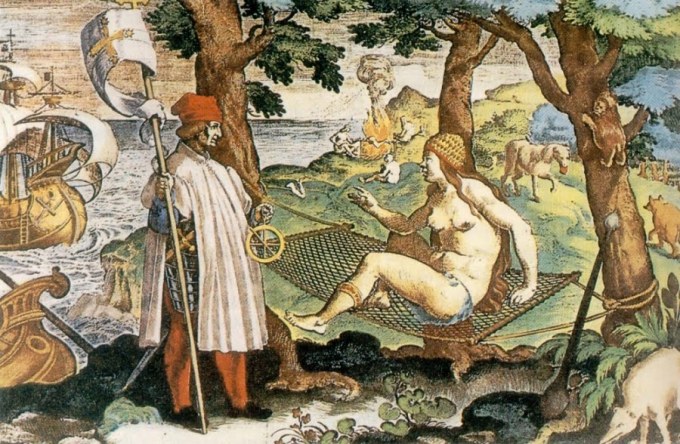
Jan Van Der Straet. “Amerigo Vespucci (1454-1512) landing in America, engraved by Theodor Galle (1571-1633)”. Oil on Canvas. Bibliotheque Nationale, Paris, France.
Description: Amerigo Vespucci (1454-1512) was an Italian explorer that coined the term “Americas” for the New World when he traveled to Brazil and the West Indies. Taking note of native customs on his voyage such as hammocks, the naked woman is meant to represent the Americas engaging in these native practices. Europeans viewed natives as lazy and not resisting to their arrival or conquest. This apparent lack of resistance is seen through the woman mesmerized by Vespucci and her reaching out to touch Vespucci and his foreign garb. The native society’s tendencies of cannibalism are even featured in this painting. In the background, there are people gathered around a fire roasting a human leg. Overall, this painting not only highlights the lack of resistance Europeans were met with by native people in the Americas and the cannibalistic nature of these barbaric people.
Opinion: This image is an example of the extreme sexualization women from all societies have to face. This woman is not representative of the women who live in the Americas as she is light skinned and has lighter hair. My immediate reaction to this was questioning why she was naked. I did not understand the reasoning or need for the woman to be naked as not even the minimal clothing she is wearing suggest she is a native woman. This example of ethnographic voyeurism is different than the following examples because the artists place Western standards of beauty and characteristics on this “native woman”. It is striking to me how long the sexualization and objectification of women has existed in human history. To this day, women still march to end these societal practices that are detrimental to the safety, success, and equality of females.
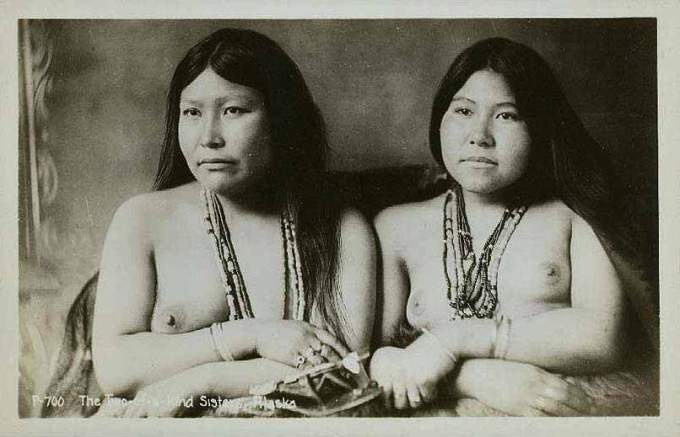
Unknown “The Two-of-a-kind Sisters, Alaska”. 1906-1913. Photograph. MetroPostcard History of Postcards 1906-1913.
Description: In the early 19th century, postcards and the production of them were on the rise in North America. This particular postcard is a part of images that was used as a way to connect with the outside world, particularly with native, indigenous peoples.
Opinion: When looking at this postcard, I immediately thought this was a perfect example of ethnographic voyeurism. This postcard is “intended” to provide more academic knowledge or exposure of Native Americans. However, this postcard does not provide any insight into the lives of native peoples of America but simply reduces these two women into sexual objects. I believe even the format of this ethnographic voyeurism is significant in that the women are presented in a manner that distances the viewer from the subject, creating the mindset that this is acceptable since it is just a photograph. It reinforces the objectification of these women and encourages an outlet for Westerner’s erotic fantasies.
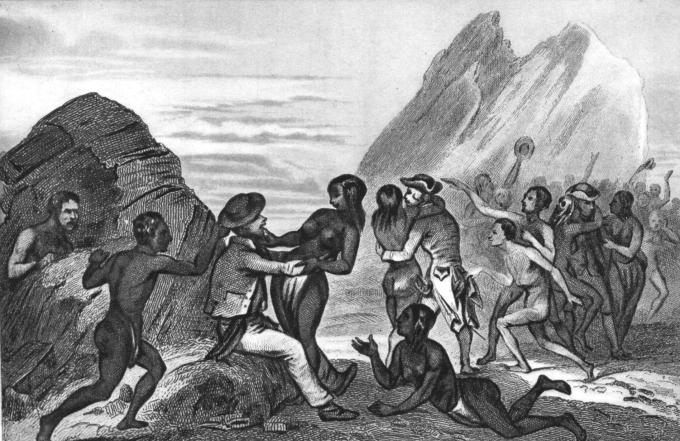
Description: European travelers arriving to what is presently named Easter Island. The Polynesian women are enthralled with the European men. Despite this activity being deemed as unacceptable by women in Western societies, it is a topic of discussion amongst Europeans as evident through the recreation of an image depicting this apparent event.
Opinion: Again, this reoccurring image of native women eager to meet European travelers is seen throughout history. It is extremely voyeuristic for European male audiences specifically because here is a constant image of ethnic women fighting to engage in sexual activities with these men. This sexualization of women is almost turned into an advertisement for white European men to travel to the New World so they can be treated as sex gods by native women. Looking further at this image, it is also emasculating the native men in this image as they can’t seem to control their women as they run to the arms of white men. The men are illustrated as on the floor begging for the native woman’s hand or restraining another woman from joining a European. Europeans are saying the men can not control their women and in this time period, patriarchal society and gender norms were very heavily enforced. This engraving is detrimental to the images of both native men and women. It also leads to the race craft and the power structure that will later be implemented on ethnic groups, placing them at the bottom.
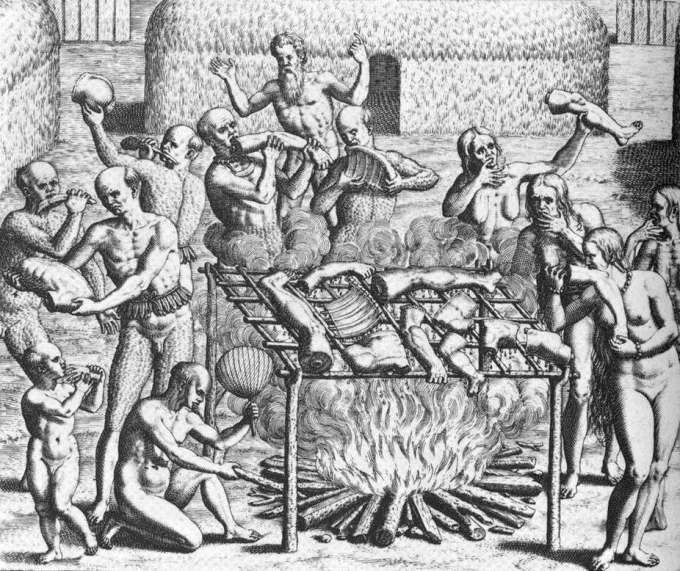
Theodor de Bry (1528-1598). “The Sons of Pindorama”. before 1562. Gravure. http://www.westga.edu.
Description: This 16th century printing is said to be depicting cannibalism in Brazil in 1557 as described by Hans Staden (c.1525-1579). Hans Staden was a German explorer who traveled to South America. While exploring, he claims that he was captured by the Tupinamba people of Brazil. The most significant story he told of the native people he encountered in Brazil was of their practices of cannibalism. Staden’s stories and the print reimagining this incident paint this society in South America as barbaric people. Staden claims he was served a soup that contained small skulls of the choir boys at the bottom of the bowl. This print serves to instill fear into Europeans about the people living in the New World and create an image of the atrocities supposedly occurring across the world.
Opinion: This image is created to dehumanize those living in the Americas and establish a legitimacy to the claims of European explorers such as Staden. As seen in the image, the men have animal like skin on their thighs, most similar to reptiles. They look nonhuman and frankly quite demonic with pointed teeth and oddly shaped heads. Everyone in the image is naked and do not indicate any native identity apart from the necklaces and belts worn by some and the cannibalism. This image is a way for colonizers to have a reason behind the cruelty that they imposed on native peoples in the Americas. The nakedness and cannibalism creates an Othering of this society and is the beginning of racial divisions in the world.
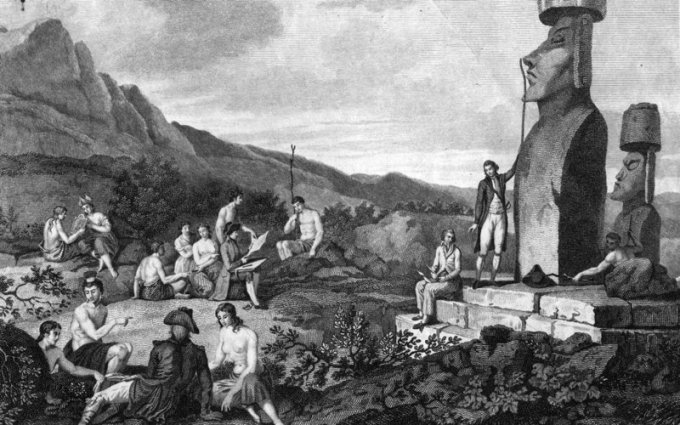
“Islanders and Monuments of Easter Island” engraving from A voyage round the world in the years 1785-1788 by Jean-Francois de Galaup de La Perouse (1741-1788). Polynesia, 18th century. De Agostini Picture Library.
Description: Jean-Francois de Galaup (1741-c.1788) was a French explorer of the New World. He arrived at Easter Island in 1786. The image above depicts the native Polynesian women of the island welcoming de Galaup and his men when they reached land. The women are topless and engaged in conversations with the French sailors.
Opinion: Similar to Straet’s painting, this image depicts native women as fawning over Europeans. Typically, Western culture shuns women who are promiscuous and engage in sexual activity before marriage. However, I feel as if this image depicts women in a sexualized way without the criticism and disapproval mostly accompanied with these ethnographic voyeurism images. The lack of negativity surrounding the nudity of the women does not make up for the depiction of these women as sexual objects. The women are there to listen to the stories of the sailors. Personally, I see the existence of these women in this painting as a way to inflate the ego of the men and European men in general. Once again, native women are utilized as commodities and objects that benefit the white European man.